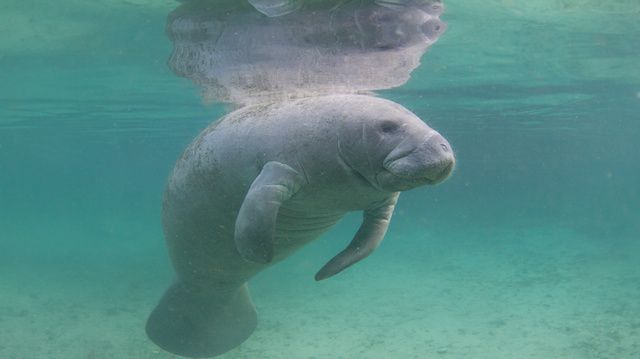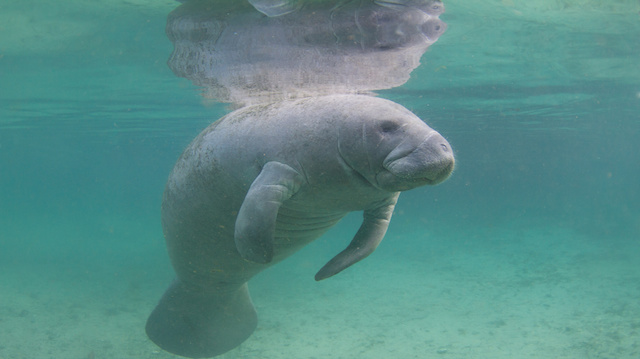
After almost 50 years, the manatee is finally being removed from the endangered species list. The efforts of conservationists and a strong public education campaign has given this species a second chance.
The southern coastal region of the United States, particularly Florida, is home to a subspecies of West Indian manatees. Manatees are water mammals, which means that although they live in the water, they don’t have gills and must breathe air.
While similar to seals in some respects, manatees are not as sleek. Manatees are born weighing in between 40 and 60 pounds. They usually grow to be 10 feet long and end up weighing 800 to 1,200 pounds.
This size is supported by a ravenous diet, as they can eat up to nine percent of their own body weight per day.
Despite their girth, they are still be very agile swimmers. However, they do seem to prefer a slower pace, matching their gentle disposition.
Why were they endangered?
Since 1967, manatees have been protected by the Endangered Species Act (ESA). In the early 1990s, aerial surveys of the coastline showed that there were as few as 1,200 manatees in existence. Now they number over 6,300.
Manatees were once hunted, but now under the ESA they only face danger from illegal poaching or from accidents. Most manatees that are injured or killed have been hit by boat motors or fishing gear. Surprisingly, they have no natural predators, probably due to their size.
Manatees don’t produce a lot of offspring, which is part of the reason they have taken so long to come back from endangerment. They tend to live an average of 30 years, and during that time the females can have one or two calves every two to five years. This does not allow for a very rapid expansion of the species.
How does a species get removed from the ESA?
Any creature that faces imminent extinction can be added to the “endangered” category under the ESA. Species are considered “threatened” when their population is not so low to be considered endangered but endangerment is likely without future intervention.
When manatees first went on the list, they were certainly on the brink. When a species has so few individuals left, the loss of even one, accidental or not, is a huge blow. As numbers are reduced, it becomes harder and harder to find a mate. Considering the slow rate of reproduction in manatees, this effect was only exaggerated.
Thankfully, manatees are now at a point where the population is less affected by the loss of one manatee. This does not mean, however, that they are completely recovered. The laws are not going to be any less strict.
How does the ESA protect the manatees?
By law, it is illegal to harm manatees in any way. Even annoying or harassing a manatee can be punished with severe fines or jail time. The maximum federal sentence for harming a manatee is a fine of $100,000 and/or one year of jail time. With a punishment so steep, most people give manatees a wide berth.
 It has been a long slow journey for the manatees, but now that they no longer seem to be at such high risk, officials are ready to drop the endangered status and be content with a threatened status. This will not change the penalties for harming manatees, but it does mean that the species may be allowed to continue to grow on its own without the need for such intense human intervention.
It has been a long slow journey for the manatees, but now that they no longer seem to be at such high risk, officials are ready to drop the endangered status and be content with a threatened status. This will not change the penalties for harming manatees, but it does mean that the species may be allowed to continue to grow on its own without the need for such intense human intervention.
Ongoing challenges include the loss of habitat and pollution that destroys their primary source of food. However, this can be hailed as a story of success. Manatees are beautiful, graceful creatures, and now they have a strong chance to continue as a species.
The next time you’re out on a boat in Florida and see a large grayish-white mass under the surface, observe from a safe distance and enjoy the show. Respect this creature and give it plenty of space. This is one way that you can contribute to the survival of this gentle species.
—Kyle Kramer
Kyle is an outdoor enthusiast with a passion for nature and sustainability. When he is not writing, you will find him in his workshop crafting with local wood, hiking in the Arizona mountains, fly fishing, horseback riding or putting together a healthy meal in the kitchen.
Sources:
http://www.reuters.com/article/us-florida-manatee-idUSKBN0UL21G20160107?feedType=RSS&feedName=environmentNews
https://www.nwf.org/Wildlife/Wildlife-Conservation/Endangered-Species-Act.aspx
https://www.nwf.org/Wildlife/Wildlife-Library/Mammals/West-Indian-Manatee.aspx

